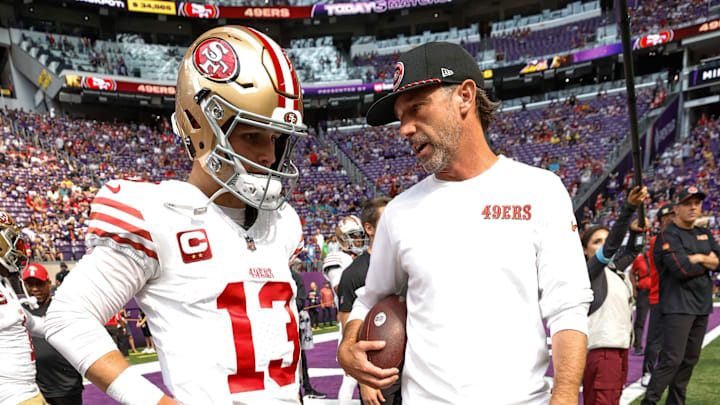The 49ers offense looks nothing like it did a season ago, and one can argue it's hindering Brock Purdy and Co.
The San Francisco 49ers' Week 5 loss to the Arizona Cardinals revealed plenty of issues for quarterback Brock Purdy and the offense.
Sure, Purdy and Co. got off to a 23-point first half. But, Arizona fully shut the Niners out after halftime, while Purdy committed two turnovers and had all kinds of difficulty in the red zone.
Additionally, the two sacks Purdy took during the game were almost entirely on him for scrambling about and holding onto the ball for far too long.
The game is a mere microcosm of what's going on with head coach Kyle Shanahan's offense this year. Sure, there's plenty of blame to go around amid the 2-3 start. The defense is embattled, while special teams have largely been atrocious.
But Shanahan's offense isn't exactly clicking either. Why?
Perhaps it has to do with San Francisco turning into a "drop back, wait and throw" kind of team instead of what Shanahan previously deployed prior to 2024.
And there are stats to prove it, as well as stats that reveal the side effects.
Brock Purdy, 49ers are moving away from play-action offense
Granted, not having All-Pro running back Christian McCaffrey (Achilles) in the fray hurts. Opponents focus on McCaffrey to a massive degree, and one can only wonder if his availability would have meant the 49ers wouldn't have lost to either Arizona, or the Los Angeles Rams back in Week 3.
Shanahan has long utilized a run-first offense, thereby setting up play action and taking advantage of defenses guarding against the threat of a run.
This year, however, Shanahan has let Purdy operate more from a traditional drop-back scheme. According to Pro Football Focus, the Niners have used play-action plays just 17.6 percent of the time, compared to 23.1 percent of offensive snaps a season ago.
Additionally, Purdy's time to throw is an NFL-high 3.37 seconds, per PFF, whereas it was 2.74 seconds in 2023.
That's a substantial difference. While it does suggest Purdy is taking advantage of his scrambling abilities and evading pressure with his legs, or at least taking time to let plays develop, it also points out the quick-strike element he enjoyed so much last year simply isn't there in 2024.
This has led to some less-than-desirable side effects over the first five weeks.
Ramifications of Kyle Shanahan not using more play action
Purdy holding onto the ball for longer periods of time has consequences. Sure, it opens up the chance of big plays, and the quarterback currently leads the league in average yards per attempt (8.8).
However, with 12 sacks taken, it's exposing Purdy to more pressure. In 2023, Purdy's sack percentage was 5.93. Through five weeks, it's already up to 7.1.
The entire offense is seeing a shift, too. For years, Shanahan's offenses were known for picking up chunk yards after the catch, frequently leading the league or ranking close to the top in that category. In 2023, San Francisco owned the fourth-most YAC with 2,209. Separation created by play action influenced that number.
To date, however, the 49ers rank next to last of teams who've played at least five games with just 411 YAC.
Yes, McCaffrey's absence is a factor here. However, with running back Jordan Mason boasting three 100-yard rush games out of five, averaging 5.1 yards per carry in the process, it's not as if the Niners lack an effective ground game that fails to set up play action.
Simply put, Shanahan needs to rein in Purdy to a slight degree by dialing up what worked for the offense for so long: a run-first approach with more play action, thereby putting Purdy and the rest of his weapons into a better position to succeed.
